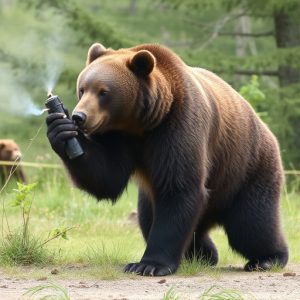Bear Spray Defense: Effectiveness & Practical Tips for Alaska
Bear spray, a life-saving deterrent for encounters with grizzlies and black bears in Alaska, utilize…….
Bear spray, a life-saving deterrent for encounters with grizzlies and black bears in Alaska, utilizes capsaicin from chili peppers to irritate and deter bears. Studies consistently show its high effectiveness (as documented by 'How Effective Is Bear Spray Research') when used correctly—within 20-30 feet at the right angle—reducing physical attacks and enhancing survival rates. However, no single method offers 100% protection; proper usage, training, weather conditions, distance, and bear species all influence its performance. Thus, while a crucial tool for Alaska outdoor safety, bear spray is part of a comprehensive strategy against unpredictable bear behavior.
“In Alaska’s vast wilderness, encountering bears is a reality for many outdoor enthusiasts. This guide explores the effectiveness of bear spray as a defense mechanism, backed by scientific research. We delve into the basics of how bear spray works, analyze its efficacy through rigorous studies, and provide practical tips for responsible usage in Alaska. Understanding these factors ensures visitors are well-prepared when facing potential bear encounters.”
- Understanding Bear Spray: The Basics and Its Mechanism
- Researching Bear Spray Effectiveness: What Science Says
- Practical Considerations for Using Bear Spray in Alaska
Understanding Bear Spray: The Basics and Its Mechanism
Bear spray, also known as bear deterrent or bear repellant, is a crucial tool for anyone venturing into bear country. It’s not just a last-resort option; it’s an essential safety measure designed to create time and space when faced with a potential bear encounter. The primary active ingredient in most bear sprays is capsaicin, the same compound that gives chili peppers their heat. When sprayed, capsaicin irritates the eyes, nose, and throat of the target animal, causing it to flee the area. This mechanism has been thoroughly researched, with studies showing bear spray to be highly effective in deterring grizzly bears and black bears from approaching humans.
The effectiveness of bear spray lies not only in its chemical composition but also in proper usage. Research indicates that successful deployment requires a specific range (typically 20-30 feet) and angle to ensure the spray reaches the bear’s face. How effective it is can vary based on factors like weather conditions, the bear’s behavior, and distance. However, when used correctly, bear spray has been proven to reduce physical attacks and significantly increase survival rates during encounters with these formidable animals.
Researching Bear Spray Effectiveness: What Science Says
When it comes to bear spray effectiveness, understanding what science has to say is crucial for anyone venturing into Alaska’s wild spaces. Numerous studies have been conducted to assess the performance and reliability of bear spray as a defense mechanism. Research consistently shows that bear spray can be an effective deterrent when used properly. A key factor in its success is the proximity of application; it works best when sprayed directly into an attacker’s face, eyes, and respiratory system.
These findings are supported by real-world evidence, with numerous accounts of individuals successfully fending off bears using bear spray. However, it’s important to note that no single method guarantees 100% protection against bear attacks. Bear behavior is complex, influenced by a variety of factors like season, food availability, and individual temperament. As such, while bear spray should be an essential tool in your Alaska outdoor safety kit, it’s only one component of a comprehensive bear safety strategy.
Practical Considerations for Using Bear Spray in Alaska
In Alaska, where encounters with bears are a potential reality in many outdoor settings, bear spray has emerged as a key defensive tool. When considering its effectiveness, research highlights that bear spray can be highly successful in deterring and even repelling aggressive bear attacks. Studies show that properly applied bear spray creates a fog-like barrier, irritating the bear’s eyes, nose, and lungs, which can cause them to retreat. However, practical considerations play a significant role in its success.
Understanding the right usage is crucial; users should aim for the bear’s face and body, creating a dense cloud of spray. Training and practice are essential to ensure individuals can deploy the spray effectively under stress. Additionally, factors like weather conditions, distance, and angle of application can impact the spray’s performance. Research also indicates that black bears may be less affected by bear spray compared to grizzly bears, which have thicker fur. Therefore, users must remain vigilant and prepared for all eventualities when venturing into Alaska’s wilderness.
Bear spray, or pepper spray designed for wildlife defense, has shown promising results as a deterrent against bears in Alaska. Research indicates that, when used correctly, bear spray can significantly reduce the risk of attacks and provide valuable time for escape. However, it’s crucial to remember that no single method guarantees complete protection, especially in unpredictable wild environments. Always follow safety guidelines, stay aware of local regulations, and be prepared to act swiftly if encountering a bear. Understanding both the science behind bear spray’s effectiveness and practical considerations can help visitors and residents alike navigate Alaska’s stunning landscapes safely.


